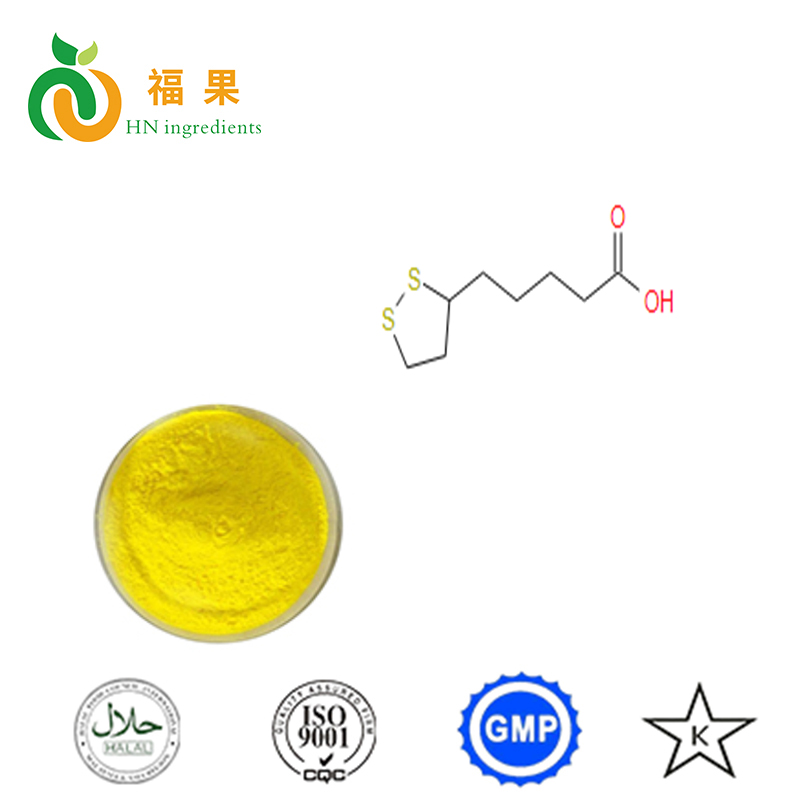
Alpha-Lipoic Acid (ALA), chemically known as C₈H₁₄O₂S₂, is a unique dithiol compound distinguished by its dual hydrophilic and lipophilic properties, enabling blood-brain barrier penetration and systemic diffusion. Initially discovered in 1937, ALA was first isolated from pig liver by American scientists Reed et al. in 1951. The pioneering chemical synthesis achieved in 1952 by Homberger Jr et al. marked the commencement of industrial production.
Functioning as an essential cofactor in mitochondrial dehydrogenase complexes, ALA participates in pivotal oxidative decarboxylation reactions in cellular energy metabolism. Since the 1960s, ALA has been employed for treating diabetic neuropathy, gaining widespread recognition post-1990 as a "universal antioxidant" due to its exceptional antioxidant and anti-aging properties.
ALA exists as two enantiomers: bioactive R-ALA and inactive but non-toxic S-ALA, with commercial products typically comprising racemic mixtures. Traditional chemical synthesis required 9 steps with merely 50% theoretical yield.
Revolutionary progress emerged through chemoenzymatic synthesis developed by East China University of Science and Technology, reducing steps to 6 while increasing yield by 40%, lowering costs by 20%, and achieving 99% optical purity. Implementation by Fushilai Pharmaceutical boosted total yield from 25% to 55%.
Current industrial production favors routes using 6,8-dichloroethyl octanoate or cyclohexanone as starting materials for their shorter pathways and reduced environmental impact. China has established global production dominance, accounting for over 90% of worldwide capacity.
ALA's exceptional therapeutic value stems from its potent antioxidant capabilities, directly neutralizing free radicals while regenerating other antioxidants including vitamin C, vitamin E, and glutathione. Its multifaceted mechanisms encompass:
Participation in tricarboxylic acid cycle regulation
Glucose-dependent improvement of insulin sensitivity
Heavy metal chelation and detoxification
Neuroprotection against oxidative damage
Clinically, ALA demonstrates remarkable efficacy against diabetic neuropathy. The ALADIN trial confirmed that intravenous ALA administration significantly improved lower extremity sensitivity and reduced plasma lipid peroxidation in diabetic patients. Additional applications include radiation injury, cataracts, cardiovascular diseases, and growing cosmetic and nutraceutical uses for anti-aging and skin revitalization.
The global ALA market reached $166 million in 2023, with projections indicating growth to $1.236 billion by 2027 at a 6.3% CAGR (2021-2027). China's ALA injection sales in public hospitals surpassed 521 million RMB in 2023.
Regional characteristics demonstrate:
China: Global production leader and major exporter, with 80-90% output exported despite domestic consumption representing only ~12% of global total
North America: Highest regional growth rate
Europe: Long-standing medicinal applications with dual status as pharmaceutical and dietary supplement
Japan: Dominates 70% of global ALA patents in cosmetics and health foods
Pharmaceutical applications dominate market value, accounting for approximately $500 million globally, with 80% dedicated to diabetes management. The nutraceutical segment reached $377 million in 2020.
With rising global diabetes prevalence (projected 643 million patients by 2030) and increasing health consciousness, ALA demand will maintain steady growth. Product structure is upgrading toward high-value R-ALA, predicted to exceed $1 billion market by 2027.
Production innovations like enzymatic synthesis promise 25-30% cost reduction for R-ALA, enhancing accessibility. Novel applications in neurodegenerative diseases and NAFLD are expanding.
Chinese manufacturers like Fushilai are strengthening global competitiveness through technological innovation, with industry concentration increasing (CR2 reaching 80%). With ongoing advances in synthetic biology and application development, ALA's significance in the global health industry will continue to escalate.